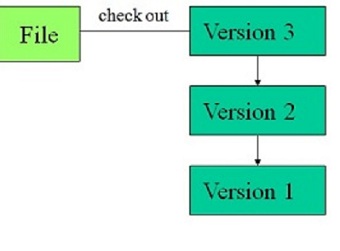CSC/ECE 517 Fall 2011/ch1 1f sv
Comparing version - control systems from the programmer's stand point
Introduction : Version Control Systems
Version Control System (VCS) is a software that allows to manage changes of documents, programs, images and other information that is stored in form of computer files. Changes are usually identified by an incrementing number or letter code also known as revision number or revision.The simplest usage of versioning is - you can easily go back to the previous working version of your files, should you mess something up with the latest changes.Changes could range from fixing a typo in a text file up to a huge refactoring in a software project, spanning hundreds of files. Each change usually has name of the person introduced it, time of the change and an optional description message.
Types of Version Control Systems
The version control systems can be classified into three categories:
1. Local version Control
In the local-only approach, all developers must use the same computer system. These software often manage single files individually and are largely replaced or embedded within newer software.
Examples of this approach are:
Revision Control System (RCS) stores the latest version and backward deltas for fastest access to the trunk tip compared to SCCS and an improved user interface, at the cost of slow branch tip access and missing support for included/excluded deltas.
Source Code Control System (SCCS) is a part of UNIX and is based on interleaved deltas, and can construct versions as arbitrary sets of revisions. Extracting an arbitrary version takes essentially the same speed and is thus more useful in environments that rely heavily on branching and merging with multiple "current" and identical versions.
2. Client - Server Model
In the client-server model, developers use a shared single repository.
Open Source
Concurrent Versions System (CVS) was originally built on RCS and licensed under the GPL.
CVS uses a client–server architecture: a server stores the current version(s) of a project and its history, and clients connect to the server in order to "check out" a complete copy of the project, work on this copy and then later "check in" their changes. Typically, the client and server connect over a LAN or over the Internet, but client and server may both run on the same machine if CVS has the task of keeping track of the version history of a project with only local developers. The server software normally runs on Unix (although at least the CVSNT server also supports various flavors of Microsoft Windows), while CVS clients may run on any major operating-system platform.
Several developers may work on the same project concurrently, each one editing files within their own "working copy" of the project, and sending (or checking in) their modifications to the server. To avoid the possibility of people stepping on each others' toes, the server will only accept changes made to the most recent version of a file. Developers are therefore expected to keep their working copy up-to-date by incorporating other people's changes on a regular basis. This task is mostly handled automatically by the CVS client, requiring manual intervention only when an edit conflict arises between a checked-in modification and the yet-unchecked local version of a file. If the check in operation succeeds, then the version numbers of all files involved automatically increment, and the CVS-server writes a user-supplied description line, the date and the author's name to its log files. CVS can also run external, user-specified log processing scripts following each commit. These scripts are installed by an entry in CVS's loginfo file, which can trigger email notification or convert the log data into a Web-based format. Clients can also compare versions, request a complete history of changes, or check out a historical snapshot of the project as of a given date or as of a revision number.
Subversion (svn) is a versioning control system inspired by CVS.
